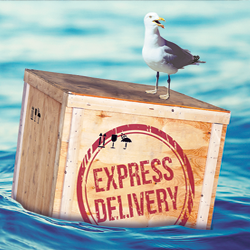|
exhibiting 101

Checking the Right Boxes
Avoid shipping snafus by making sure your freight carrier has all the information it needs.
Keeping your transportation
provider in the dark can dismally
affect the timely and safe delivery
of your precious exhibit freight. When
it came to shipping my first exhibit, I
had no earthly idea what information
to share with my carrier. But when
disaster befell that first shipment, I
quickly learned the pain exhibitors
feel when their freight doesn't end
up where or when it's supposed to
simply because critical details weren't
conveyed to the carrier.
So what information should you provide when requesting a shipping quote or filling out a shipping order? Since every exhibitor's shipping requirements are different – from transporting helicopter fuselages to getting frozen pizzas to a food show – it's hard to give advice for every possible scenario and potential problem. But here are six pieces of information I recommend sharing with your carrier to ensure your exhibit freight arrives on time and on budget. Type of Freight Let your carrier know exactly what you're shipping so it can determine the type of trucking or air freight equipment required and under what tariff it will ship. Transporting exhibit properties such as carpet, walls, and graphics is an entirely different ballgame than shipping heavy equipment that requires a flatbed trailer. If your shipment needs to be refrigerated on its way to the show site or is especially fragile, let your carrier know beforehand. The same goes if you're shipping multiple types of freight, your exhibit, display products, and miscellaneous marketing items, such as giveaways, collateral literature, and staff uniforms. Each freight category can have its own challenges, not to mention different shipping rates. Type of Shipping Containers Your freight might be loaded in crates, banded or stretch-wrapped on pallets, packed in wheeled cases or loose cartons, or blanket-wrapped (aka pad-wrapped). Each method of packing will affect the dimensions of your shipment and ultimately how it can be loaded. For example, will your carpet and padding be bagged in rolls, crated, or stacked on a pallet or carpet pig? Can the containers be stacked to save room or laid on their sides if the height of the case exceeds that of the truck door or top of the trailer? Knowing these answers in advance will help you get an accurate quote and avoid last-minute snafus. Dimensions and Weight Your carrier will need to know the size of the various containers you'll be shipping, which should be provided in cubic feet. To get this figure, multiply the height, length, and width of each piece of freight in inches and then divide this number by 1,728. Let's say one piece of freight is 54 inches long, 30 inches wide, and 33 inches high. The package measures 53,460 cubic inches, or nearly 31 cubic feet (as 53,460 divided by 1,728 equals 30.94). You'll also need to estimate the weight of your total shipment, since there may be limitations on what your carrier's equipment can handle. If in doubt about the weight of your shipment, look at past material-handling bills for similar shipments or use the rule of thumb that an average cubic foot of freight weighs about 9 pounds. The importance of these calculations will come to light when you see the term "Dim Wt" on your shipping invoice – and no, the carrier isn't slamming your intellectual prowess. "Dim Wt" stands for dimensional weight (aka volumetric weight), which is used to calculate minimum shipping charges for the cubic space a package occupies. Case in point: Shipping two identically sized boxes, one containing feathers and the other one bricks, and charging only by their real weight would be unprofitable for the carrier since both packages take up the same amount of space but obviously don't weigh the same. As such, shipping charges are generally determined by the greater of the actual weight and dimensional weight of a package. So yes, size matters! All of this information will help your carrier compute the total cubic feet your freight will take up so it can reserve space and estimate your shipping charges. But note that the estimate it provides is based on the info you've shared, so "garbage in, garbage out." If the size of your shipment increases, expect your invoice to increase. However, if your shipment shrinks, don't expect your bill to follow suit, since the carrier used your estimate to reserve space that can't be resold to another customer. An important side note: If you don't go through the steps of calculating the dimensions and weight of every last piece of freight, be sure to provide the measurements for the largest piece you'll be shipping so the carrier can make sure its standard equipment and vehicles can accommodate it. Number of Pickup and Delivery Locations It's not at all unusual for exhibitors to need carriers to pick up freight from various locations and deliver it to multiple destinations. For example, you may have a hanging sign that needs to ship from your company's headquarters to the general service contractor's (GSC's) advance warehouse. You may also have a pickup of your display properties at your exhibit house that needs to be delivered to either the advance warehouse or directly to the show site. Then throw in those extra pallets of event-marketing materials that need to ship to a hotel in the same show city for the off-site hospitality event you're holding for VIP clients. It goes without saying that these additional logistical factors can affect your shipping estimate. But it never hurts to ask if you can consolidate these multiple shipments for cost savings based on your total shipping volume, leaving you to just pay an additional fee for each of the extra pickups or deliveries. Pickup Dates and Times The next piece of information your carrier needs is when the shipment will be ready for pickup and when the freight has to arrive at its destination. I always try to build an extra day or two into the schedule just in case a problem arises due to inclement weather, mechanical failure, or even human error. Also consider that the less time your carrier has between your desired pickup and delivery, the more expensive your shipment will be, as it may have to be expedited by adding a second driver or putting it on a plane. And how closely should you target your freight pickup? Do you tell the carrier it can pick it up on Tuesday, Tuesday afternoon, or only on Tuesday between 3 p.m. and 4 p.m.? If your shipment is only available to the carrier between certain hours instead of all day, this can create what's known in the transportation industry as a "special" that will cost you more since the carrier's other stops have to be scheduled around yours. And if the targeted pickup or delivery time isn't within normal working hours, expect an off-hours surcharge. Special Equipment or Additional Labor Be sure to let your carrier know of any special equipment you may need to facilitate the movement of your freight, such as a liftgate on the carrier's truck if your company doesn't have a truck-level loading dock, pallet jacks, J-bars for adjusting crates, or stacker bars for securing stacked or rolling freight. And if your pickup location isn't on the ground floor, there may be distance-based fees for the extra labor or equipment needed to negotiate the freight onto an elevator or down a flight of stairs. These may seem like minor considerations, but you'd be surprised how quickly labor and equipment-rental fees can add up. Bottom line: Exhibit managers tend to oversimplify specialized exhibit shipping – until they live through a freight-related crisis. But by being upfront with your carrier about all your shipping requirements, getting your exhibit to the show floor can be as stress-free as a Sunday drive. E  Candy Adams
Candy AdamsCTSM, CEM, CMP, CMM "The Booth Mom," is an independent exhibit project manager, trainer, speaker, consultant, and an Exhibitor Conference faculty member. CandyAdams@BoothMom.com
|
|
|
||||||||||||||||||||||||||||
|
|
||||||||||||||||||||||||||||
|
TOPICS Measurement & Budgeting Planning & Execution Marketing & Promotion Events & Venues Personal & Career Exhibits & Experiences International Exhibiting Resources for Rookies Research & Resources |
MAGAZINE Subscribe Today! Renew Subscription Update Address Digital Downloads Newsletters Advertise |
FIND-IT Exhibit & Display Producers Products & Services Supplier to Supplier All Companies Compare Get Listed |
EXHIBITORLIVE Sessions Certification Exhibit Hall Exhibit at the Show Registration |
ETRAK Sessions Certification F.A.Q. Registration |
EDUCATION WEEK Overview Sessions Hotel Registration |
CERTIFICATION The Program Steps to Certification Faculty and Staff Enroll in CTSM Submit Quiz Answers My CTSM |
AWARDS Sizzle Awards Exhibit Design Awards Portable/Modular Awards Corporate Event Awards Centers of Excellence |
NEWS Associations/Press Awards Company News International New Products People Shows & Events Venues & Destinations EXHIBITOR News |
||||||||||||||||||||
|
||||||||||||||||||||||||||||






